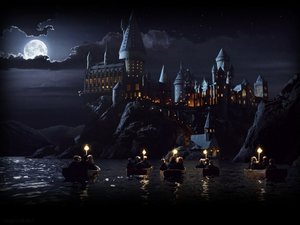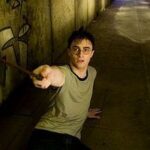Harry Potter – the name is now synonymous with magic in the modern era. Nobody in the modern world can fail to have at least heard the name, even if they have never read the books, or seen one of the blockbuster films. How did this happen, how could a simple children’s tale become such a worldwide blockbuster success, netting JK Rowling more than 4 billion dollars in gross sales in just over 10 years? One word, technology. It was technology that allowed the story of Harry to spread far beyond his British roots. Technology carried the images of Hogwarts to the theatres and TV screens of the world, and showed us what it was like inside that magical school. Technology has given us a glimpse into the fantastic. Technology even allowed us to see what Fluffy, a 3 headed dog, would look like. The technology behind the Harry Potter phenomenon is varied and complex – we’ll try to break it down so that the fantastic can be somewhat explained.
Books-
In just over ten years, the Harry Potter books have been printed, revised, and reprinted over a staggering 325,000,000 times. To handle such a load, normal printing presses would fail or seize. Digital printing presses and Web offset presses have become commonplace. And that technolgoy has allowed for the high speed mass production that can allow for 325,000,000+ impressions of the books, some of which can exceed 800 pages. Offset presses don’t use a traditional printing plate, instead, they use a rubber sheet that is coated with ink, then this is impressed with the image, and then transferred to the paper as it speeds past at as much as 25 mph. The paper roll is then fed into a cutter, which slices it into the smaller sheets that are then cut by machine and assembled into a completed book. Using this modern technology, one Harry Potter book can be produced in as little as 6 hours, instead of as much as 4 days for traditional methods. Additionally, with the high volume of the Offset press, normally, a print run would include as many as 50,000 books at a time per press.
Video Games-
All video games start off as an idea. This is then explained to the team that is directly involved in development, normally called the Core programming team. These people have a straightforward yet terribly complex job. To produce something which is called a Game Engine. This is the heart of any video game and is the groundwork upon which a video game is built. The first three Harry Potter games were built using the Unreal Engine, made by Epic Games back in 1998 and now owned by Electronic Arts. This game engine has proven to be very portable, and has been adapted to hundreds of other titles, including Tom Clancy’s Rainbow 6, and Gears of War. Harry Potter and the Goblet of Fire, as well as Harry Potter and Order of The Phoenix were built using a different game mechanics engine and have received better reviews than the first three games because they feel better. Even though Azkaban was not considered a very good game by all standards.
Once the Core Programming team has gotten their assignments, they begin to weave their magic. Wrapping C programming code around the logic of the console or computer hardware to ensure the game mechanics will work the same on any platform the game is run on; be it a PS3, The Wii, or an Apple Mac. At the same time, a differnt team is put in charge of artwork. They are skilled at 3d modelling, and their job is to create 3d models using programs such as 3d Max, Maya, or SoftImage that can reproduce on a computer screen, the look and feel of the universe portrayed. For Harry Potter, this meant reproducing all the locations, objects, and the characters themselves in 3D. Animating them, and making them look as close as possible to the movies that the games have been adapted from.
A seperate sound team defines and digitally encodes all the sound bytes and music so that when the Core team is ready, the sound files can be loaded up, synchronized, and made to work within the game play experiecne.
A video game normally takes around 12 months to make, and can employ as many as 200 people at a staggering cost of over $20 million dollars. To make the Harry Potter games, EA Games, the group behind blockbuster hits like The Sims and Sims 2, spun it off to their UK branch to take over. So that JK Rowling could keep an eye on the video game development of her property.
Once everything is put together, playtesting begins, and once that has passed and everything has been tested to destruction and bug fixed. Then the game is ready for packaging and shipment to the hungry game players of the world so they can live in Harry’s world and be a part of his magic.
Movies-
This is the most visual and in a lot of ways, the most important aspect of Harry Potter. Bringing the world of the young wizard to life on the big screen, so hundreds of millions can view his life and feel as if they are a part of it. Watching him grow, passing from a boy into a young adult. Seeing his trials and challenges unfold. Viewing his life and all it entails. That is the goal of the films. Technology is used all through these visual masterpieces to allow the legend of Harry Potter to unfold.
Jim Henson’s Creature Shop – the team behind the Muppets, Farscape, and all sorts of other animatronic puppetry, was brought on board for the first film, and they never looked back. They were responsible for Fluffy the three-headed guard dog. And in all the films, their magic in showing puppets as being living creatures has allowed for a more appealing experience all around.
Image Magic – a technology group behind the film Polar Express, where they digitally recreated every character, has been brought onboard during the lastest film, ‘Half-Blood Prince’ to animate Hagrid’s half-brother Grawp. Like the Dragons, Dobby, and other characters, Grawp is fully digital – allowing for a dose of realism not often seen in today’s films. The digital effects in Harry Potter don’t look digital. They are crafted to look real – correctly lit, with proper movements, and when required, they breathe as well. This all adds to making them look more real than a lot of other films that claim to have realistic animations.
Industrial Light and Magic – the powerhouse visual effects factory built by George Lucas, has also been on board the films since the beginning. Their skill in digital reproduction as well as stunning visual effects lends them to being the best of the best. They were behind the incredible flying fight scene between Harry and the Dragon in ‘Goblet Of Fire’ as well as the Quiddich match in the first movie.
The addition of all the visual effects can be a wow factor, but it by no means makes the film. Visual effects only enhances what is already there. With JK Rowling fully in control of every aspect, she retains creative control over the films’ development. It can be understood that nothing passes until she feels it is right or looks correct. Every major aspect of the films, from the look of Hogwarts down to the style of clothing the major characters wear, is checked with JK Rowling to ensure it is in line with her vision.
Science and technology together have brought a mystical magical world to life for us to enjoy. What began as a dream one night by a mother to tell her child for bedtime has now become a worldwide phenomenon that continues to break records and wow audiences around the world. And even with the release of the final book in the series coming very soon, and the last two movies in production – we will have a lot to enjoy with Harry Potter for some time now. It truly has changed the way we look upon our world.





